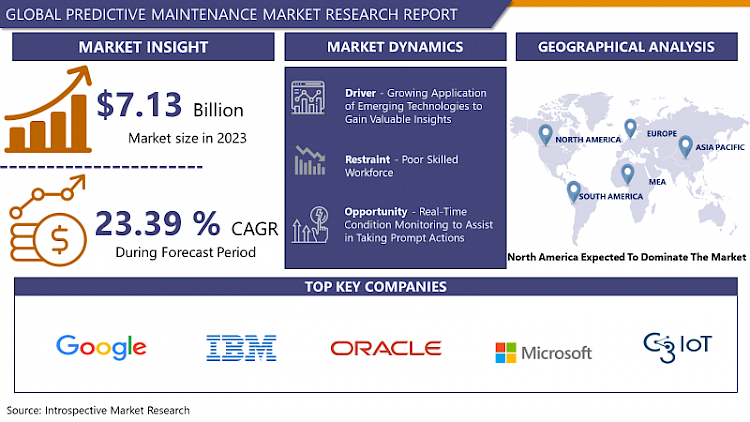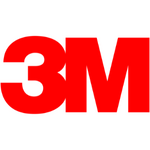Global Predictive Maintenance Market Overview
Predictive Maintenance Market Size Was Valued at USD 7.13 Billion in 2023 and is Projected to Reach USD 47.27 Billion by 2032, Growing at a CAGR of 23.39% From 2024-2032
Predictive maintenance is a technology that applies for the data analysis tools and techniques to determine inconsistency in the operation and possible defects in equipment and processes so we can fix them before they fail. Preferably, predictive maintenance enables the maintenance frequency to be as low as possible to prevent unplanned reactive maintenance, without suffering costs related to doing too much-preventing maintenance. Furthermore, predictive maintenance uses historical and real-time data from different parts of the operation to expect problems before they happen. The major areas of the company that factor into predictive maintenance such as the real-time monitoring of asset condition and performance, the analysis of work order data, benchmarking MRO inventory usage. There is a various key component to predictive maintenance with technology and software being one of these critical pieces such as the artificial intelligence, Internet of Things (IoT), and integrated system allow for various assets and systems to connect, work together and analyze, share, and action data. These tools record information utilizing industrial controls, predictive maintenance sensors, and businesses systems (such as EAM software and ERP software). They then make sense of it and utilize it to identify any areas that require focus.
Moreover, for instance, using predictive maintenance and predictive maintenance sensors include vibration analysis, thermal imaging, oil analysis, and equipment observation which leads the growth of the market during the forecast period. Moreover, the importance of predictive maintenance such as if predictive maintenance is working successfully as a maintenance strategy, maintenance is only performed on machines when it is needed. Therefore, just before failure is probably to occur. This brings different cost savings, reducing the time the equipment is being maintained, decreasing the production hours lost to maintenance, overcome the cost of spare parts and supplies which helps to growth of the market in the course of the forecast period. Predictive maintenance programs have been shown to support the tenfold increase in ROI, a 25%-30% decrease in maintenance costs, a 70%-75% reduction of breakdowns, and a 35%-45% minimize in downtime. Some condition monitoring techniques are costly and need specialist and experienced personnel for data analysis to be effective.

Market Dynamics and Factors of Predictive Maintenance Market
Drivers:
Evaluating the aggressive time constraints for different industrial products and services, it is important to recognize the causes of failures or potential faults before they have a chance to occur. Developing technologies such as Internet of Things (IoT) cloud storage, and big data analytics are qualified more industrial equipment and assembly robots to provide condition-based data, making fault detection easier and practical. Information received from this equipment can be turned into actionable and meaningful insights by using these solutions. This is anticipated to stimulate the demand for these solutions over the globe.
Companies are deploying their maintenance services more effectively and are boosting equipment up-time by proactively determining potential issues by using the available data within the plant. The faults or failures of the equipment or plant can be determined easily by effectively using the available structural data. The structural data pointers include working hours, year of production, model, make, warranty details along with unstructured data mainly repair logs and maintenance history. This information allows organizations to predict if or when the equipment will fail so that the repair works can be carried out before the failure occurs.
Predictive maintenance can be applied to all industry verticals where machines create significant amounts of data and require maintenance. Industries such as healthcare, aerospace, manufacturing, automotive, and process industries such as chemicals, food, and beverage, oil, and gas can be transformed with the help of these solutions. In addition, apart from the advantages such as reducing downtime, removing the causes of failure, and managing repair costs, these solutions also employ non-intrusive testing techniques for evaluating and computing asset performance trends.
Restraints:
Insufficient accessibility of skilled workforce with suitable knowledge of operating the predictive maintenance solution is a major challenge experienced by the organizations. Trained workers are required to handle the new software systems to deploy AI-based IoT technologies and skillsets. Therefore, the existing workers are required to be trained on how to operate the latest and upgraded systems. Furthermore, industries are dynamic toward approving new technologies, however, they are experiencing a scarcity of highly skilled workforce and proficient workers.
Opportunities:
Real-time condition monitoring to support in taking prompt actions. Upgraded asset management is growingly needed across almost every vertical. Solution providers equipped with AI and ML can collect and turn the vast amount of customer-related data into significant insights, as IoT generates a huge amount of data from connected devices. AI can also be non-segregated with the IoT devices to improve various aspects of service delivery, such as predictive maintenance and quality assessment, without the need for any human interference. The real-time inputs from sensors, actuators, and other control parameters would not only predict embryonic asset failures but also support companies monitor in real-time and take quick actions.
Market Segmentation
Segmentation Analysis of Predictive Maintenance Market:
Based on the Components, the solution component accounted for the largest market share during the forecast period. Owing to the rising concern of organizations towards cutting down the cost and advancement in the uptime of equipment.
Based on Deployment Type, the on-premise segment is expected to dominate the overall predictive maintenance market and is anticipated to maintain its dominance over the forecast period. This is imputed to its modular sensors and easier deployments in pre-existing equipment. Nevertheless, cloud-based predictive maintenance solutions are anticipated to exhibit the highest growth rate over the projected period, due to remote accessibility, direct IT control, efficient resource internal data delivery & handling, faster data processing using advance predictive analytics, utilization, and cost-effectiveness.
Based on the Organization Size, the large enterprise segment dominates the market over the forecast period. These enterprises are developing and automating their operational maintenance process by using these solutions. Furthermore, the cost related to downtime and assets in large enterprises is very high. To reduce these challenges predictive maintenance solutions are progressively being deployed in large enterprises over the world.
Based on the Industry Vertical, the manufacturing segment is expected to dominate the global market during the forecast period. The increasing requirement for maintenance of producing equipment such as machinery, industrial robots, elevators, and pumps for decreasing the overall downtime is turning the adoption of predictive maintenance solutions and services in the manufacturing segment. Furthermore, the growing automation in the manufacturing sector coupled with Industry 4.0 is also expected to drive the demand for these solutions to protect the high-end equipment from losses.
Regional Analysis of Predictive Maintenance Market:
North America is expected to hold a maximum market share over the forecast period. The region is the market commander in the advancement and acquisition of advanced predictive maintenance solutions. This can be assigned to the presence of a large number of leading solutions and service providers. Furthermore, higher investments made in developing technologies such as IoT, artificial intelligence, and machine learning are expected to support the region to maintain its dominant position shortly. Moreover, higher awareness related to predictive maintenance measures and their importance is also producing significant demand for these solutions.
The Asia Pacific is expected to observe significant market share during the forecast period. The higher growth of the market in the region is especially attributed to huge investments done by public and private sectors for the improvement of asset maintenance solutions. Hence, increasing the demand for predictive maintenance solutions deployed for automating the maintenance process of the plant. Furthermore, the higher availability of cheap labor in the region has led to the establishment of a massive number of producing units in the region. Furthermore, growing concerns for decreasing overall downtime and operation costs in producing plants are compelling the plant owners to deploy these solutions.
Europe is expected to hold a significant market share during the forecast period. The high demand for predictive maintenance solutions, due to the rising organizational investments and consciousness about the benefits of predictive maintenance technology to reach competitive advantages.
The Middle East and Africa are expected to observe a stable growth rate in the predictive maintenance market. Growing demand for more cost-efficient predictive maintenance solutions and a tendency towards minimizing machine breakdowns will create the growth of the predictive maintenance market over the region.
Players Covered in Predictive Maintenance Market are:
- Google (US)
- IBM (US)
- Oracle(US)
- Microsoft (US)
- Sigma Industrial Precision (Spain)
- C3 IoT (US)
- Hitachi (Japan)
- RapidMiner (US)
- PTC (US)
- GE (US)
- Schneider Electric (France)
- SAS (US)
- TIBCO (US)
- Softweb Solutions (US)
- A system (France)
- Ecolibrium Energy (India)
- Fiix Software (Canada)
- OPEX Group (UK)
- Seebo (Israel)
- Dingo (Australia)
- Software AG (Germany)
- HPE (US)
- Uptake (US)
- AWS (US)
- Micro Focus (UK)
- SAP (Germany)
- Splunk (US)
- Altair (US)
- ReliaSol (Netherlands)
Key Industry Developments of Predictive Maintenance Market
- In February 2024, Siemens is releasing a new generative artificial intelligence (AI) functionality into its predictive maintenance solution Senseye Predictive Maintenance. This advance makes predictive maintenance more conversational and intuitive. Through this new release of Senseye Predictive Maintenance with generative AI functionality, Siemens will make human-machine interactions and predictive maintenance faster and more efficient by enhancing proven machine learning capabilities with generative AI.
- In March 2024, Oracle introduced Oracle Smart Operations, a new supply chain execution feature in its Fusion Cloud Supply Chain & Manufacturing (SCM). This feature, powered by AI, can enhance productivity, and quality, reduce unplanned downtime, and improve operational visibility. The new capabilities, which are part of Oracle Fusion Cloud Manufacturing and Oracle Fusion Cloud Maintenance, aim to help organizations stay competitive by enhancing factory efficiency, reducing unplanned downtime risks, and expanding visibility across operations. Oracle Smart Operations offers connected, intelligent, and automated capabilities, enabling customers to make better business decisions with agile execution.
|
Global Predictive Maintenance Market |
|||
|
Base Year: |
2023 |
Forecast Period: |
2024-2032 |
|
Historical Data: |
2017 to 2023 |
Market Size in 2023: |
USD 7.13 Bn. |
|
Forecast Period 2024-32 CAGR: |
23.39 % |
Market Size in 2032: |
USD 47.27 Bn. |
|
Segments Covered: |
By Component |
|
|
|
By Deployment |
|
||
|
By Vertical |
|
||
|
By Region |
|
||
|
Key Market Drivers: |
|
||
|
Key Market Restraints: |
|
||
|
Key Opportunities: |
|
||
|
Companies Covered in the report: |
|
||
Chapter 1: Introduction
1.1 Research Objectives
1.2 Research Methodology
1.3 Research Process
1.4 Scope and Coverage
1.4.1 Market Definition
1.4.2 Key Questions Answered
1.5 Market Segmentation
Chapter 2:Executive Summary
Chapter 3:Growth Opportunities By Segment
3.1 By Component
3.2 By Deployment
3.3 By Vertical
Chapter 4: Market Landscape
4.1 Porter's Five Forces Analysis
4.1.1 Bargaining Power of Supplier
4.1.2 Threat of New Entrants
4.1.3 Threat of Substitutes
4.1.4 Competitive Rivalry
4.1.5 Bargaining Power Among Buyers
4.2 Industry Value Chain Analysis
4.3 Market Dynamics
4.3.1 Drivers
4.3.2 Restraints
4.3.3 Opportunities
4.5.4 Challenges
4.4 Pestle Analysis
4.5 Technological Roadmap
4.6 Regulatory Landscape
4.7 SWOT Analysis
4.8 Price Trend Analysis
4.9 Patent Analysis
4.10 Analysis of the Impact of Covid-19
4.10.1 Impact on the Overall Market
4.10.2 Impact on the Supply Chain
4.10.3 Impact on the Key Manufacturers
4.10.4 Impact on the Pricing
Chapter 5: Predictive Maintenance Market by Component
5.1 Predictive Maintenance Market Overview Snapshot and Growth Engine
5.2 Predictive Maintenance Market Overview
5.3 Solutions
5.3.1 Introduction and Market Overview
5.3.2 Historic and Forecasted Market Size (2016-2028F)
5.3.3 Key Market Trends, Growth Factors and Opportunities
5.3.4 Solutions: Grographic Segmentation
5.4 Services
5.4.1 Introduction and Market Overview
5.4.2 Historic and Forecasted Market Size (2016-2028F)
5.4.3 Key Market Trends, Growth Factors and Opportunities
5.4.4 Services: Grographic Segmentation
Chapter 6: Predictive Maintenance Market by Deployment
6.1 Predictive Maintenance Market Overview Snapshot and Growth Engine
6.2 Predictive Maintenance Market Overview
6.3 Cloud
6.3.1 Introduction and Market Overview
6.3.2 Historic and Forecasted Market Size (2016-2028F)
6.3.3 Key Market Trends, Growth Factors and Opportunities
6.3.4 Cloud: Grographic Segmentation
6.4 On-Premise
6.4.1 Introduction and Market Overview
6.4.2 Historic and Forecasted Market Size (2016-2028F)
6.4.3 Key Market Trends, Growth Factors and Opportunities
6.4.4 On-Premise: Grographic Segmentation
Chapter 7: Predictive Maintenance Market by Vertical
7.1 Predictive Maintenance Market Overview Snapshot and Growth Engine
7.2 Predictive Maintenance Market Overview
7.3 Government & Defense
7.3.1 Introduction and Market Overview
7.3.2 Historic and Forecasted Market Size (2016-2028F)
7.3.3 Key Market Trends, Growth Factors and Opportunities
7.3.4 Government & Defense: Grographic Segmentation
7.4 Energy & Utilities
7.4.1 Introduction and Market Overview
7.4.2 Historic and Forecasted Market Size (2016-2028F)
7.4.3 Key Market Trends, Growth Factors and Opportunities
7.4.4 Energy & Utilities: Grographic Segmentation
7.5 Manufacturing
7.5.1 Introduction and Market Overview
7.5.2 Historic and Forecasted Market Size (2016-2028F)
7.5.3 Key Market Trends, Growth Factors and Opportunities
7.5.4 Manufacturing: Grographic Segmentation
7.6 Healthcare
7.6.1 Introduction and Market Overview
7.6.2 Historic and Forecasted Market Size (2016-2028F)
7.6.3 Key Market Trends, Growth Factors and Opportunities
7.6.4 Healthcare: Grographic Segmentation
7.7 Transportation & Logistics
7.7.1 Introduction and Market Overview
7.7.2 Historic and Forecasted Market Size (2016-2028F)
7.7.3 Key Market Trends, Growth Factors and Opportunities
7.7.4 Transportation & Logistics: Grographic Segmentation
7.8 Other Verticals
7.8.1 Introduction and Market Overview
7.8.2 Historic and Forecasted Market Size (2016-2028F)
7.8.3 Key Market Trends, Growth Factors and Opportunities
7.8.4 Other Verticals: Grographic Segmentation
Chapter 8: Company Profiles and Competitive Analysis
8.1 Competitive Landscape
8.1.1 Competitive Positioning
8.1.2 Predictive Maintenance Sales and Market Share By Players
8.1.3 Industry BCG Matrix
8.1.4 Ansoff Matrix
8.1.5 Predictive Maintenance Industry Concentration Ratio (CR5 and HHI)
8.1.6 Top 5 Predictive Maintenance Players Market Share
8.1.7 Mergers and Acquisitions
8.1.8 Business Strategies By Top Players
8.2 GOOGLE
8.2.1 Company Overview
8.2.2 Key Executives
8.2.3 Company Snapshot
8.2.4 Operating Business Segments
8.2.5 Product Portfolio
8.2.6 Business Performance
8.2.7 Key Strategic Moves and Recent Developments
8.2.8 SWOT Analysis
8.3 IBM
8.4 ORACLE
8.5 MICROSOFT
8.6 SIGMA INDUSTRIAL PRECISION
8.7 C3 IOT
8.8 HITACHI
8.9 RAPIDMINER
8.10 PTC
8.11 GE
8.12 SCHNEIDER ELECTRIC
8.13 SAS
8.14 TIBCO
8.15 SOFTWEB SOLUTIONS
8.16 A SYSTEM
8.17 ECOLIBRIUM ENERGY
8.18 FIIX SOFTWARE
8.19 OPEX GROUP
8.20 SEEBO
8.21 DINGO
8.22 SOFTWARE AG
8.23 HPE
8.24 UPTAKE
8.25 AWS
8.26 MICRO FOCUS
8.27 SAP
8.28 SPLUNK
8.29 ALTAIR
8.30 RELIASOL
8.31 OTHER MAJOR PLAYERS
Chapter 9: Global Predictive Maintenance Market Analysis, Insights and Forecast, 2016-2028
9.1 Market Overview
9.2 Historic and Forecasted Market Size By Component
9.2.1 Solutions
9.2.2 Services
9.3 Historic and Forecasted Market Size By Deployment
9.3.1 Cloud
9.3.2 On-Premise
9.4 Historic and Forecasted Market Size By Vertical
9.4.1 Government & Defense
9.4.2 Energy & Utilities
9.4.3 Manufacturing
9.4.4 Healthcare
9.4.5 Transportation & Logistics
9.4.6 Other Verticals
Chapter 10: North America Predictive Maintenance Market Analysis, Insights and Forecast, 2016-2028
10.1 Key Market Trends, Growth Factors and Opportunities
10.2 Impact of Covid-19
10.3 Key Players
10.4 Key Market Trends, Growth Factors and Opportunities
10.4 Historic and Forecasted Market Size By Component
10.4.1 Solutions
10.4.2 Services
10.5 Historic and Forecasted Market Size By Deployment
10.5.1 Cloud
10.5.2 On-Premise
10.6 Historic and Forecasted Market Size By Vertical
10.6.1 Government & Defense
10.6.2 Energy & Utilities
10.6.3 Manufacturing
10.6.4 Healthcare
10.6.5 Transportation & Logistics
10.6.6 Other Verticals
10.7 Historic and Forecast Market Size by Country
10.7.1 U.S.
10.7.2 Canada
10.7.3 Mexico
Chapter 11: Europe Predictive Maintenance Market Analysis, Insights and Forecast, 2016-2028
11.1 Key Market Trends, Growth Factors and Opportunities
11.2 Impact of Covid-19
11.3 Key Players
11.4 Key Market Trends, Growth Factors and Opportunities
11.4 Historic and Forecasted Market Size By Component
11.4.1 Solutions
11.4.2 Services
11.5 Historic and Forecasted Market Size By Deployment
11.5.1 Cloud
11.5.2 On-Premise
11.6 Historic and Forecasted Market Size By Vertical
11.6.1 Government & Defense
11.6.2 Energy & Utilities
11.6.3 Manufacturing
11.6.4 Healthcare
11.6.5 Transportation & Logistics
11.6.6 Other Verticals
11.7 Historic and Forecast Market Size by Country
11.7.1 Germany
11.7.2 U.K.
11.7.3 France
11.7.4 Italy
11.7.5 Russia
11.7.6 Spain
11.7.7 Rest of Europe
Chapter 12: Asia-Pacific Predictive Maintenance Market Analysis, Insights and Forecast, 2016-2028
12.1 Key Market Trends, Growth Factors and Opportunities
12.2 Impact of Covid-19
12.3 Key Players
12.4 Key Market Trends, Growth Factors and Opportunities
12.4 Historic and Forecasted Market Size By Component
12.4.1 Solutions
12.4.2 Services
12.5 Historic and Forecasted Market Size By Deployment
12.5.1 Cloud
12.5.2 On-Premise
12.6 Historic and Forecasted Market Size By Vertical
12.6.1 Government & Defense
12.6.2 Energy & Utilities
12.6.3 Manufacturing
12.6.4 Healthcare
12.6.5 Transportation & Logistics
12.6.6 Other Verticals
12.7 Historic and Forecast Market Size by Country
12.7.1 China
12.7.2 India
12.7.3 Japan
12.7.4 Singapore
12.7.5 Australia
12.7.6 New Zealand
12.7.7 Rest of APAC
Chapter 13: Middle East & Africa Predictive Maintenance Market Analysis, Insights and Forecast, 2016-2028
13.1 Key Market Trends, Growth Factors and Opportunities
13.2 Impact of Covid-19
13.3 Key Players
13.4 Key Market Trends, Growth Factors and Opportunities
13.4 Historic and Forecasted Market Size By Component
13.4.1 Solutions
13.4.2 Services
13.5 Historic and Forecasted Market Size By Deployment
13.5.1 Cloud
13.5.2 On-Premise
13.6 Historic and Forecasted Market Size By Vertical
13.6.1 Government & Defense
13.6.2 Energy & Utilities
13.6.3 Manufacturing
13.6.4 Healthcare
13.6.5 Transportation & Logistics
13.6.6 Other Verticals
13.7 Historic and Forecast Market Size by Country
13.7.1 Turkey
13.7.2 Saudi Arabia
13.7.3 Iran
13.7.4 UAE
13.7.5 Africa
13.7.6 Rest of MEA
Chapter 14: South America Predictive Maintenance Market Analysis, Insights and Forecast, 2016-2028
14.1 Key Market Trends, Growth Factors and Opportunities
14.2 Impact of Covid-19
14.3 Key Players
14.4 Key Market Trends, Growth Factors and Opportunities
14.4 Historic and Forecasted Market Size By Component
14.4.1 Solutions
14.4.2 Services
14.5 Historic and Forecasted Market Size By Deployment
14.5.1 Cloud
14.5.2 On-Premise
14.6 Historic and Forecasted Market Size By Vertical
14.6.1 Government & Defense
14.6.2 Energy & Utilities
14.6.3 Manufacturing
14.6.4 Healthcare
14.6.5 Transportation & Logistics
14.6.6 Other Verticals
14.7 Historic and Forecast Market Size by Country
14.7.1 Brazil
14.7.2 Argentina
14.7.3 Rest of SA
Chapter 15 Investment Analysis
Chapter 16 Analyst Viewpoint and Conclusion
|
Global Predictive Maintenance Market |
|||
|
Base Year: |
2023 |
Forecast Period: |
2024-2032 |
|
Historical Data: |
2017 to 2023 |
Market Size in 2023: |
USD 7.13 Bn. |
|
Forecast Period 2024-32 CAGR: |
23.39 % |
Market Size in 2032: |
USD 47.27 Bn. |
|
Segments Covered: |
By Component |
|
|
|
By Deployment |
|
||
|
By Vertical |
|
||
|
By Region |
|
||
|
Key Market Drivers: |
|
||
|
Key Market Restraints: |
|
||
|
Key Opportunities: |
|
||
|
Companies Covered in the report: |
|
||
LIST OF TABLES
TABLE 001. EXECUTIVE SUMMARY
TABLE 002. PREDICTIVE MAINTENANCE MARKET BARGAINING POWER OF SUPPLIERS
TABLE 003. PREDICTIVE MAINTENANCE MARKET BARGAINING POWER OF CUSTOMERS
TABLE 004. PREDICTIVE MAINTENANCE MARKET COMPETITIVE RIVALRY
TABLE 005. PREDICTIVE MAINTENANCE MARKET THREAT OF NEW ENTRANTS
TABLE 006. PREDICTIVE MAINTENANCE MARKET THREAT OF SUBSTITUTES
TABLE 007. PREDICTIVE MAINTENANCE MARKET BY COMPONENT
TABLE 008. SOLUTIONS MARKET OVERVIEW (2016-2028)
TABLE 009. SERVICES MARKET OVERVIEW (2016-2028)
TABLE 010. PREDICTIVE MAINTENANCE MARKET BY DEPLOYMENT
TABLE 011. CLOUD MARKET OVERVIEW (2016-2028)
TABLE 012. ON-PREMISE MARKET OVERVIEW (2016-2028)
TABLE 013. PREDICTIVE MAINTENANCE MARKET BY VERTICAL
TABLE 014. GOVERNMENT & DEFENSE MARKET OVERVIEW (2016-2028)
TABLE 015. ENERGY & UTILITIES MARKET OVERVIEW (2016-2028)
TABLE 016. MANUFACTURING MARKET OVERVIEW (2016-2028)
TABLE 017. HEALTHCARE MARKET OVERVIEW (2016-2028)
TABLE 018. TRANSPORTATION & LOGISTICS MARKET OVERVIEW (2016-2028)
TABLE 019. OTHER VERTICALS MARKET OVERVIEW (2016-2028)
TABLE 020. NORTH AMERICA PREDICTIVE MAINTENANCE MARKET, BY COMPONENT (2016-2028)
TABLE 021. NORTH AMERICA PREDICTIVE MAINTENANCE MARKET, BY DEPLOYMENT (2016-2028)
TABLE 022. NORTH AMERICA PREDICTIVE MAINTENANCE MARKET, BY VERTICAL (2016-2028)
TABLE 023. N PREDICTIVE MAINTENANCE MARKET, BY COUNTRY (2016-2028)
TABLE 024. EUROPE PREDICTIVE MAINTENANCE MARKET, BY COMPONENT (2016-2028)
TABLE 025. EUROPE PREDICTIVE MAINTENANCE MARKET, BY DEPLOYMENT (2016-2028)
TABLE 026. EUROPE PREDICTIVE MAINTENANCE MARKET, BY VERTICAL (2016-2028)
TABLE 027. PREDICTIVE MAINTENANCE MARKET, BY COUNTRY (2016-2028)
TABLE 028. ASIA PACIFIC PREDICTIVE MAINTENANCE MARKET, BY COMPONENT (2016-2028)
TABLE 029. ASIA PACIFIC PREDICTIVE MAINTENANCE MARKET, BY DEPLOYMENT (2016-2028)
TABLE 030. ASIA PACIFIC PREDICTIVE MAINTENANCE MARKET, BY VERTICAL (2016-2028)
TABLE 031. PREDICTIVE MAINTENANCE MARKET, BY COUNTRY (2016-2028)
TABLE 032. MIDDLE EAST & AFRICA PREDICTIVE MAINTENANCE MARKET, BY COMPONENT (2016-2028)
TABLE 033. MIDDLE EAST & AFRICA PREDICTIVE MAINTENANCE MARKET, BY DEPLOYMENT (2016-2028)
TABLE 034. MIDDLE EAST & AFRICA PREDICTIVE MAINTENANCE MARKET, BY VERTICAL (2016-2028)
TABLE 035. PREDICTIVE MAINTENANCE MARKET, BY COUNTRY (2016-2028)
TABLE 036. SOUTH AMERICA PREDICTIVE MAINTENANCE MARKET, BY COMPONENT (2016-2028)
TABLE 037. SOUTH AMERICA PREDICTIVE MAINTENANCE MARKET, BY DEPLOYMENT (2016-2028)
TABLE 038. SOUTH AMERICA PREDICTIVE MAINTENANCE MARKET, BY VERTICAL (2016-2028)
TABLE 039. PREDICTIVE MAINTENANCE MARKET, BY COUNTRY (2016-2028)
TABLE 040. GOOGLE: SNAPSHOT
TABLE 041. GOOGLE: BUSINESS PERFORMANCE
TABLE 042. GOOGLE: PRODUCT PORTFOLIO
TABLE 043. GOOGLE: KEY STRATEGIC MOVES AND DEVELOPMENTS
TABLE 043. IBM: SNAPSHOT
TABLE 044. IBM: BUSINESS PERFORMANCE
TABLE 045. IBM: PRODUCT PORTFOLIO
TABLE 046. IBM: KEY STRATEGIC MOVES AND DEVELOPMENTS
TABLE 046. ORACLE: SNAPSHOT
TABLE 047. ORACLE: BUSINESS PERFORMANCE
TABLE 048. ORACLE: PRODUCT PORTFOLIO
TABLE 049. ORACLE: KEY STRATEGIC MOVES AND DEVELOPMENTS
TABLE 049. MICROSOFT: SNAPSHOT
TABLE 050. MICROSOFT: BUSINESS PERFORMANCE
TABLE 051. MICROSOFT: PRODUCT PORTFOLIO
TABLE 052. MICROSOFT: KEY STRATEGIC MOVES AND DEVELOPMENTS
TABLE 052. SIGMA INDUSTRIAL PRECISION: SNAPSHOT
TABLE 053. SIGMA INDUSTRIAL PRECISION: BUSINESS PERFORMANCE
TABLE 054. SIGMA INDUSTRIAL PRECISION: PRODUCT PORTFOLIO
TABLE 055. SIGMA INDUSTRIAL PRECISION: KEY STRATEGIC MOVES AND DEVELOPMENTS
TABLE 055. C3 IOT: SNAPSHOT
TABLE 056. C3 IOT: BUSINESS PERFORMANCE
TABLE 057. C3 IOT: PRODUCT PORTFOLIO
TABLE 058. C3 IOT: KEY STRATEGIC MOVES AND DEVELOPMENTS
TABLE 058. HITACHI: SNAPSHOT
TABLE 059. HITACHI: BUSINESS PERFORMANCE
TABLE 060. HITACHI: PRODUCT PORTFOLIO
TABLE 061. HITACHI: KEY STRATEGIC MOVES AND DEVELOPMENTS
TABLE 061. RAPIDMINER: SNAPSHOT
TABLE 062. RAPIDMINER: BUSINESS PERFORMANCE
TABLE 063. RAPIDMINER: PRODUCT PORTFOLIO
TABLE 064. RAPIDMINER: KEY STRATEGIC MOVES AND DEVELOPMENTS
TABLE 064. PTC: SNAPSHOT
TABLE 065. PTC: BUSINESS PERFORMANCE
TABLE 066. PTC: PRODUCT PORTFOLIO
TABLE 067. PTC: KEY STRATEGIC MOVES AND DEVELOPMENTS
TABLE 067. GE: SNAPSHOT
TABLE 068. GE: BUSINESS PERFORMANCE
TABLE 069. GE: PRODUCT PORTFOLIO
TABLE 070. GE: KEY STRATEGIC MOVES AND DEVELOPMENTS
TABLE 070. SCHNEIDER ELECTRIC: SNAPSHOT
TABLE 071. SCHNEIDER ELECTRIC: BUSINESS PERFORMANCE
TABLE 072. SCHNEIDER ELECTRIC: PRODUCT PORTFOLIO
TABLE 073. SCHNEIDER ELECTRIC: KEY STRATEGIC MOVES AND DEVELOPMENTS
TABLE 073. SAS: SNAPSHOT
TABLE 074. SAS: BUSINESS PERFORMANCE
TABLE 075. SAS: PRODUCT PORTFOLIO
TABLE 076. SAS: KEY STRATEGIC MOVES AND DEVELOPMENTS
TABLE 076. TIBCO: SNAPSHOT
TABLE 077. TIBCO: BUSINESS PERFORMANCE
TABLE 078. TIBCO: PRODUCT PORTFOLIO
TABLE 079. TIBCO: KEY STRATEGIC MOVES AND DEVELOPMENTS
TABLE 079. SOFTWEB SOLUTIONS: SNAPSHOT
TABLE 080. SOFTWEB SOLUTIONS: BUSINESS PERFORMANCE
TABLE 081. SOFTWEB SOLUTIONS: PRODUCT PORTFOLIO
TABLE 082. SOFTWEB SOLUTIONS: KEY STRATEGIC MOVES AND DEVELOPMENTS
TABLE 082. A SYSTEM: SNAPSHOT
TABLE 083. A SYSTEM: BUSINESS PERFORMANCE
TABLE 084. A SYSTEM: PRODUCT PORTFOLIO
TABLE 085. A SYSTEM: KEY STRATEGIC MOVES AND DEVELOPMENTS
TABLE 085. ECOLIBRIUM ENERGY: SNAPSHOT
TABLE 086. ECOLIBRIUM ENERGY: BUSINESS PERFORMANCE
TABLE 087. ECOLIBRIUM ENERGY: PRODUCT PORTFOLIO
TABLE 088. ECOLIBRIUM ENERGY: KEY STRATEGIC MOVES AND DEVELOPMENTS
TABLE 088. FIIX SOFTWARE: SNAPSHOT
TABLE 089. FIIX SOFTWARE: BUSINESS PERFORMANCE
TABLE 090. FIIX SOFTWARE: PRODUCT PORTFOLIO
TABLE 091. FIIX SOFTWARE: KEY STRATEGIC MOVES AND DEVELOPMENTS
TABLE 091. OPEX GROUP: SNAPSHOT
TABLE 092. OPEX GROUP: BUSINESS PERFORMANCE
TABLE 093. OPEX GROUP: PRODUCT PORTFOLIO
TABLE 094. OPEX GROUP: KEY STRATEGIC MOVES AND DEVELOPMENTS
TABLE 094. SEEBO: SNAPSHOT
TABLE 095. SEEBO: BUSINESS PERFORMANCE
TABLE 096. SEEBO: PRODUCT PORTFOLIO
TABLE 097. SEEBO: KEY STRATEGIC MOVES AND DEVELOPMENTS
TABLE 097. DINGO: SNAPSHOT
TABLE 098. DINGO: BUSINESS PERFORMANCE
TABLE 099. DINGO: PRODUCT PORTFOLIO
TABLE 100. DINGO: KEY STRATEGIC MOVES AND DEVELOPMENTS
TABLE 100. SOFTWARE AG: SNAPSHOT
TABLE 101. SOFTWARE AG: BUSINESS PERFORMANCE
TABLE 102. SOFTWARE AG: PRODUCT PORTFOLIO
TABLE 103. SOFTWARE AG: KEY STRATEGIC MOVES AND DEVELOPMENTS
TABLE 103. HPE: SNAPSHOT
TABLE 104. HPE: BUSINESS PERFORMANCE
TABLE 105. HPE: PRODUCT PORTFOLIO
TABLE 106. HPE: KEY STRATEGIC MOVES AND DEVELOPMENTS
TABLE 106. UPTAKE: SNAPSHOT
TABLE 107. UPTAKE: BUSINESS PERFORMANCE
TABLE 108. UPTAKE: PRODUCT PORTFOLIO
TABLE 109. UPTAKE: KEY STRATEGIC MOVES AND DEVELOPMENTS
TABLE 109. AWS: SNAPSHOT
TABLE 110. AWS: BUSINESS PERFORMANCE
TABLE 111. AWS: PRODUCT PORTFOLIO
TABLE 112. AWS: KEY STRATEGIC MOVES AND DEVELOPMENTS
TABLE 112. MICRO FOCUS: SNAPSHOT
TABLE 113. MICRO FOCUS: BUSINESS PERFORMANCE
TABLE 114. MICRO FOCUS: PRODUCT PORTFOLIO
TABLE 115. MICRO FOCUS: KEY STRATEGIC MOVES AND DEVELOPMENTS
TABLE 115. SAP: SNAPSHOT
TABLE 116. SAP: BUSINESS PERFORMANCE
TABLE 117. SAP: PRODUCT PORTFOLIO
TABLE 118. SAP: KEY STRATEGIC MOVES AND DEVELOPMENTS
TABLE 118. SPLUNK: SNAPSHOT
TABLE 119. SPLUNK: BUSINESS PERFORMANCE
TABLE 120. SPLUNK: PRODUCT PORTFOLIO
TABLE 121. SPLUNK: KEY STRATEGIC MOVES AND DEVELOPMENTS
TABLE 121. ALTAIR: SNAPSHOT
TABLE 122. ALTAIR: BUSINESS PERFORMANCE
TABLE 123. ALTAIR: PRODUCT PORTFOLIO
TABLE 124. ALTAIR: KEY STRATEGIC MOVES AND DEVELOPMENTS
TABLE 124. RELIASOL: SNAPSHOT
TABLE 125. RELIASOL: BUSINESS PERFORMANCE
TABLE 126. RELIASOL: PRODUCT PORTFOLIO
TABLE 127. RELIASOL: KEY STRATEGIC MOVES AND DEVELOPMENTS
TABLE 127. OTHER MAJOR PLAYERS: SNAPSHOT
TABLE 128. OTHER MAJOR PLAYERS: BUSINESS PERFORMANCE
TABLE 129. OTHER MAJOR PLAYERS: PRODUCT PORTFOLIO
TABLE 130. OTHER MAJOR PLAYERS: KEY STRATEGIC MOVES AND DEVELOPMENTS
LIST OF FIGURES
FIGURE 001. YEARS CONSIDERED FOR ANALYSIS
FIGURE 002. SCOPE OF THE STUDY
FIGURE 003. PREDICTIVE MAINTENANCE MARKET OVERVIEW BY REGIONS
FIGURE 004. PORTER'S FIVE FORCES ANALYSIS
FIGURE 005. BARGAINING POWER OF SUPPLIERS
FIGURE 006. COMPETITIVE RIVALRYFIGURE 007. THREAT OF NEW ENTRANTS
FIGURE 008. THREAT OF SUBSTITUTES
FIGURE 009. VALUE CHAIN ANALYSIS
FIGURE 010. PESTLE ANALYSIS
FIGURE 011. PREDICTIVE MAINTENANCE MARKET OVERVIEW BY COMPONENT
FIGURE 012. SOLUTIONS MARKET OVERVIEW (2016-2028)
FIGURE 013. SERVICES MARKET OVERVIEW (2016-2028)
FIGURE 014. PREDICTIVE MAINTENANCE MARKET OVERVIEW BY DEPLOYMENT
FIGURE 015. CLOUD MARKET OVERVIEW (2016-2028)
FIGURE 016. ON-PREMISE MARKET OVERVIEW (2016-2028)
FIGURE 017. PREDICTIVE MAINTENANCE MARKET OVERVIEW BY VERTICAL
FIGURE 018. GOVERNMENT & DEFENSE MARKET OVERVIEW (2016-2028)
FIGURE 019. ENERGY & UTILITIES MARKET OVERVIEW (2016-2028)
FIGURE 020. MANUFACTURING MARKET OVERVIEW (2016-2028)
FIGURE 021. HEALTHCARE MARKET OVERVIEW (2016-2028)
FIGURE 022. TRANSPORTATION & LOGISTICS MARKET OVERVIEW (2016-2028)
FIGURE 023. OTHER VERTICALS MARKET OVERVIEW (2016-2028)
FIGURE 024. NORTH AMERICA PREDICTIVE MAINTENANCE MARKET OVERVIEW BY COUNTRY (2016-2028)
FIGURE 025. EUROPE PREDICTIVE MAINTENANCE MARKET OVERVIEW BY COUNTRY (2016-2028)
FIGURE 026. ASIA PACIFIC PREDICTIVE MAINTENANCE MARKET OVERVIEW BY COUNTRY (2016-2028)
FIGURE 027. MIDDLE EAST & AFRICA PREDICTIVE MAINTENANCE MARKET OVERVIEW BY COUNTRY (2016-2028)
FIGURE 028. SOUTH AMERICA PREDICTIVE MAINTENANCE MARKET OVERVIEW BY COUNTRY (2016-2028)
Frequently Asked Questions :
The forecast period in the Predictive Maintenance Market research report is 2024-2032.
Google (US), IBM (US),Oracle(US), Microsoft (US), Sigma Industrial Precision (Spain), C3 IoT (US), Hitachi (Japan), RapidMiner (US), PTC (US),GE (US), Schneider Electric (France), SAS (US), TIBCO (US), Softweb Solutions (US), A system (France), Ecolibrium Energy (India), Fiix Software (Canada), OPEX Group (UK), Seebo (Israel), Dingo (Australia), Software AG (Germany), HPE (US), Uptake (US),AWS (US), Micro Focus (UK), SAP (Germany), Splunk (US), Altair (US), ReliaSol (Netherlands) and other major players.
The Predictive Maintenance Market is segmented into Component, Deployment, Vertical, and region. By Component, the market is categorized into Solutions, Services. By Deployment, the market is categorized into Cloud, On-Premise. By Vertical, the market is categorized into Government & Defense, Energy & Utilities, Manufacturing, Healthcare, Transportation & Logistics, Other Verticals. By region, it is analyzed across North America (U.S.; Canada; Mexico), Europe (Germany; U.K.; France; Italy; Russia; Spain, etc.), Asia-Pacific (China; India; Japan; Southeast Asia, etc.), South America (Brazil; Argentina, etc.), Middle East & Africa (Saudi Arabia; South Africa, etc.).
Predictive maintenance is a technology that applies for the data analysis tools and techniques to determine inconsistency in the operation and possible defects in equipment and processes so we can fix them before they fail.
Predictive Maintenance Market Size Was Valued at USD 7.13 Billion in 2023 and is Projected to Reach USD 47.27 Billion by 2032, Growing at a CAGR of 23.39% From 2024-2032


































